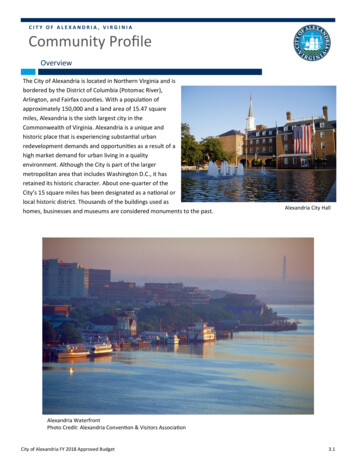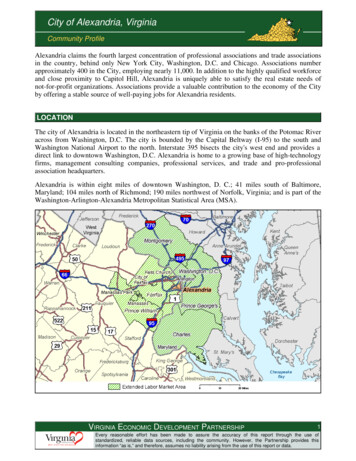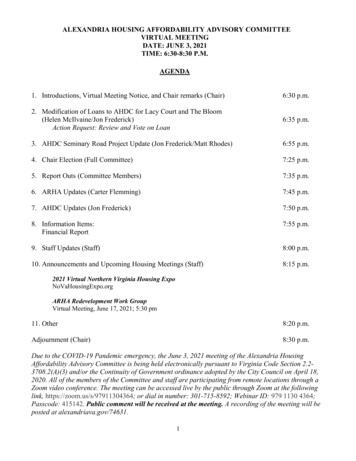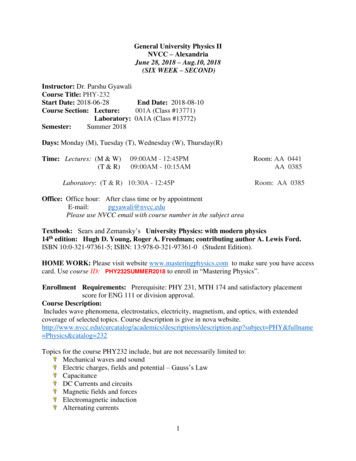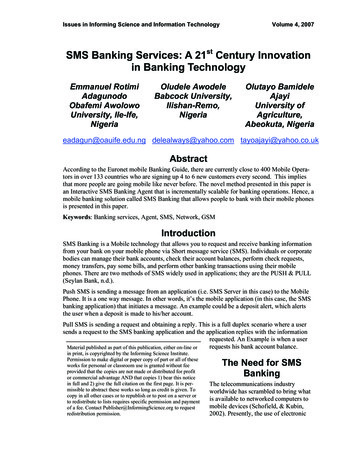
Transcription
Digital Banking2025Urs Gasser, Harvard UniversityOliver Gassmann, University of St. GallenThorsten Hens, University of ZurichLarry Leifer, Stanford UniversityThomas Puschmann, University of ZurichLeon Zhao, City University of Hong KongNovember 2017
ContentExecutive Summary31Transformation Towards Digital Banking42Banking Clients 202553Banking Operating Models 202574Banking Revenue Models 202595Digital Banking Platforms 2025126Data-driven Banking 2025147Banking Value Chain 2025168Consequences18Literature20
Executive SummaryThe accelerating disruptive effect of information technologies (IT) on value chains and business models is abolishing existing speed limits across industries. In particular, it is forecastedto have one of the greatest impacts on the financial services sector, provoking consequencessuch as disintermediation, loss of earnings, and reorganization of the value chain with newactors. Banks currently face a situation similar to that of Kodak or Olivetti, for instance, manyyears ago. Digitization led to a fundamental transformation of their core products and valuechains, which were already digital in nature.As time-to-market for digital banking products becomes shorter and shorter, thousandsof Financial Technology (FinTech) startups and other non-banks are rising to the occasionby developing new products, services, and business models for all areas of banking in payments, investments, and financing along the entire value chain, touching all areas from frontto back office, as client adoption of these new services accelerates. The lighting companyOsram, for example, recently had to reduce its worldwide staff from 34,000 to 26,000 dueto the unexpected speed of clients’ adoption of new LED technology. By contrast, a financialservices company such as Wealthfront is still small, having reached almost USD 4.5 billion inmanaged assets. Such companies develop very quickly and establish new ecosystems withother non-banks and incumbents in the financial services industry.Based on our previous research, we have developed theses and key questions for changes inthe coming years that impact six areas comprising clients, operating models, revenue models,platforms, data and value chains.3
1. Transformation TowardsDigital BankingDigitization is transforming the financial services industry. The primary drivers behind thisprocess are the enormous developments in IT and the convergence of these technologies,such as smartphones and tablet PCs with new electronic services, i.e. crowdinvesting services or electronic banking marketplaces. These developments not only enable new businessprocesses, but lead to completely new business models and even indicate an entire changeof the banking value chain in the same way as value chains in other industries, such as themedia or travel industry, were radically transformed (Ito et al., 2017). The banking industry iscurrently undergoing a transformation in six areas:1. Banking clients 2025: Decreasing physical client advisory and intensified use of electronicchannels forces many banks to adapt to new client processes and journeys, in order tokeep client contact. Future client journeys are based on hybrid client interaction thatconnects client processes among different channels and even across different companiesbridging the digital and the physical world. An example of this is a client journey thatstarts with a personal financial planning process on a tablet app guided by a digital bot,includes exchanges with other clients on social networks, contact with a client supportperson via video chat, and finally a visit with the client advisor.2. Banking operating models 2025: Operating models of banks still rely on a strong verticalintegration of management, core, and support processes. A recent development termed“hyperspecialization” indicates that sourced services tend to be more granular in thefuture and new sourcing models, such as crowdsourcing, thus emerge. Due to developments in IT (e.g., blockchain) and standardization (e.g., open APIs), banks are now ableto outsource services on the level of single tasks (e.g., DNAappstore). This atomizationof the value chain may lead to more decentralized organization structures as we knowthem today.3. Banking revenue models 2025: Decreasing market share through intensified competitionwith other banks and new non-banks, a low interest rate environment, in addition toincreasing costs as a result of regulatory requirements (e.g., retrocessions), all have led tolower profitability of banks. The development of new digital ecosystems enables banksto reposition themselves in the banking value chain, as well as in other value chains,and develop new revenue models. Among such examples are collaborations with otherproviders of innovative services, such as covesting platforms or the development of newservices, such as social community platforms for banking clients.4. Digital banking platforms 2025: New hybrid client journeys of Generation Y self-drivenclients are characterized by an increasing degree of electronic client services as well ascross-company processes that will integrate clients, banks, and third party service providers over new digital banking platforms across various points of banking. These open4
digital banking platforms integrate innovative services, such as social banking services,self-profiling services, or automated advisory services seamlessly into new client journeysand allow all involved parties to access the same end-user applications and data.5. Data-driven banking 2025: Big data is an enabler of new client-related services as wellas internal services with the purpose of gaining operational efficiency. An example thatfinds itself in the first category is cross-channel client profiles enabled by social customerrelationship management systems. The growing amount of unstructured, company-external data allows banks to obtain a more complete view of their clients and to offer newservices for them, such as a value chain optimization service for commercial clients basedon rating profiles. An example of the internal use of Big Data is the optimization of riskmanagement processes.6. Banking value chain 2025: In recent years many non-banks entered the banking valuechain. For example, there are technology companies such as Apple (ApplePay) or Google(Google Wallet) that disintermediate banks’ client relationships by providing their services directly to clients and only use banks as transaction processing providers. Anotherexample of this are providers that offer services without banks such as Wealthfront orNutmeg for investments, or peer-to-peer lending in financing. These new developmentsindicate a shift towards new banking value chains and force banks to radically rethinktheir existing business models.In order to describe the topics more precisely, the following sections outline the drivers ofchange and the key questions for CEOs in each area.2. Banking Clients 2025„The banking client 2025 is empowered by digital bots and digitallyassisted client advisors.”Recent developments in IT empower clients and lead to a fundamental change in client behavior induced by digital natives (Palfrey & Gasser, 2016), affecting existing business modelsand leading to different expectations of financial service providers. The first area of change isa general transformation in client behavior, such as the shift from ownership to experienceoriented, temporary usage towards the so-called “Sharing Economy” affecting all industries(Sundararajan, 2016). Examples are car2go from Daimler offering access to shared mobilityservices and Nextbike offering bike rental services. In the banking industry, for instance,clients share information about banking products on social networks and even share theirassets to jointly create new digital banking products without banks. The second change is5
the shift of knowledge from providers to clients induced by artificial intelligence technology.With digital bots that act as virtual assistants, clients now have access to almost all of theinformation that until now was virtually exclusively reserved for banks. Among the examplesin this category is the recent victory of Google’s artificial intelligence competition against theSouth Korean professional Go player Lee Sedol. Transferred to the banking industry, this shiftleads to a lower level of physical interaction between clients with advisors, which in consequence, could further reduce human client advisors and branches. A third area of changeare so-called “fluid expectations” that refer to expectations that clients derive from otherinteractions (e.g., if Uber allows an automated payment process, clients expect this fromother services, too). These three areas of change will ultimately be reflected in digital nativesas future employees, affecting not only client relationships but also leading to a change in future banking operating models (see section 3). Summarized, this client empowerment holdsthree transformation areas for banks:6 Digital banking self-services and automated client advisory: Bank clients intensify theiruse of electronic services and channels. Innovative technologies allow for more selfservice and automated “robot advisory,” which in the future will completely changeclient interaction and lead to a higher degree of automation without human interactionin many areas (e.g., Google driverless cars, IBM Watson client advisory). For example,collective intelligence allows for better investment decisions through the wisdom of thecrowd compared to the expert advice of individuals. At the same time, the number ofclient-facing professionals (relationship managers, assistant relationship managers, andspecialists) declined by 9% between 2008 and 2012 (Crosby et al., 2013). Hybrid, multiple provider client interaction: The increasing fusion of the digital and thephysical worlds leads to so-called no-line systems (Nüesch et al., 2015). Future clientjourneys are based on “hybrid client interaction” that not only connects client journeysamong different channels from different service providers, but also fuses the digital andthe physical world. An example of this is a client walking down a shopping mall andutilizing his smartphone camera to browse through available offers for products thathe just saw in the nearby shops. In order to adapt to such no-line systems, banks needto seamlessly integrate all relevant client touch points that in the future also require theintegration of cross-company touch points among multiple (financial) service providerscooperating in providing full client solutions. Outside-in client profiling and service matching: Instead of inside-out client profiles,which very often include demographic (e.g., age, gender, etc.) and financial data (e.g.,income, assets, etc.), new outside-in client profiles consider client-centric data, such asemotional value, social value, epistemic value, etc.) that can be used to individually tailorclient solutions to client needs through mass customization instead of traditional clientsegmentation approaches. This allows clients to individually (pre-)configure their customtailored solutions out of standardized self- and full-service components from differentservice providers that can then be bundled by clients and/or client advisors to craft specific client solutions (Sachse et al., 2014).
The outlined trends towards a more digital self-service and automated advisory, hybrid, andmulti-provider service bundling as well as outside-in client profiling and service matchinglead to three hypotheses and key questions for CEOs (see Table 1).HypothesesKey questions for CEOsH1.1: Client interaction becomes hybrid.What are future client needs and behaviors andwhat do future scenarios for hybrid client journeyslook like?H1.2: Clients advise themselves.What is the maximum degree of self-service, what isthe role of the client advisor, the “crowd” and “robot advisory,” and what client profiles are neededfor this?H1.3: Clients use multiple and different financial service providers and bundle them into custom-tailoredsolutions.How can financial services better be matched toclient needs and how can relationships be sustained through digital services and in multi-providerrelationships?Table 1: Hypotheses and Key Questions for CEOs3. Banking Operating Models 2025„Banking operating models 2025 will be characterized byintelligent automation, cooperation, and industrialization.”An “operating model” is an abstract representation of how an organization operates acrossprocess, organization, and technology domains in order to accomplish its function (De Vrieset al., 2011). In contrast to a bank’s operating model, a bank’s business model describeshow an organization creates, delivers, and captures value for its clients and sustains itself inthe process (Osterwalder & Pigneur, 2011). While business models consider revenues, costs,and resulting profitability, operating models concentrate on costs as a primary objectivethat focuses on efficiency, a topic ranked among the top two priorities of banks (Crosby etal., 2013). A drop in profit margins currently challenges many banks vis-a-vis their operatingmodels due to declining revenue margins and stable cost margins. For example, the cost margins of private banks in Asia are at the same level as in mature Western European markets(approx. 60 bp). In contrast to that Latin America and the Middle East operate with lowercost margins (approx. 40 bp) owing to the lower cost of back-office, IT, and support staff(Vandenberghe et al., 2014). In the cost category, personnel expenses represent the lion’sshare and reflect the different situations regarding cost-income ratios with approx. 80% in7
Switzerland, 70% in Germany, 60% in the U.S., 50% in Sweden and Luxemburg, 40% inSingapore and Hong Kong as well as 30% in China (Hintermann et al., 2014).Besides employee costs that account for almost 60% of banks’ costs, IT costs
Transformation Towards Digital Banking Digitization is transforming the financial services industry. The primary drivers behind this process are the enormous developments in IT and the convergence of these technologies, such as smartphones and tablet PCs with new electronic services, i.e. crowdinvesting ser- vices or electronic banking marketplaces. These developments not only enable new .





